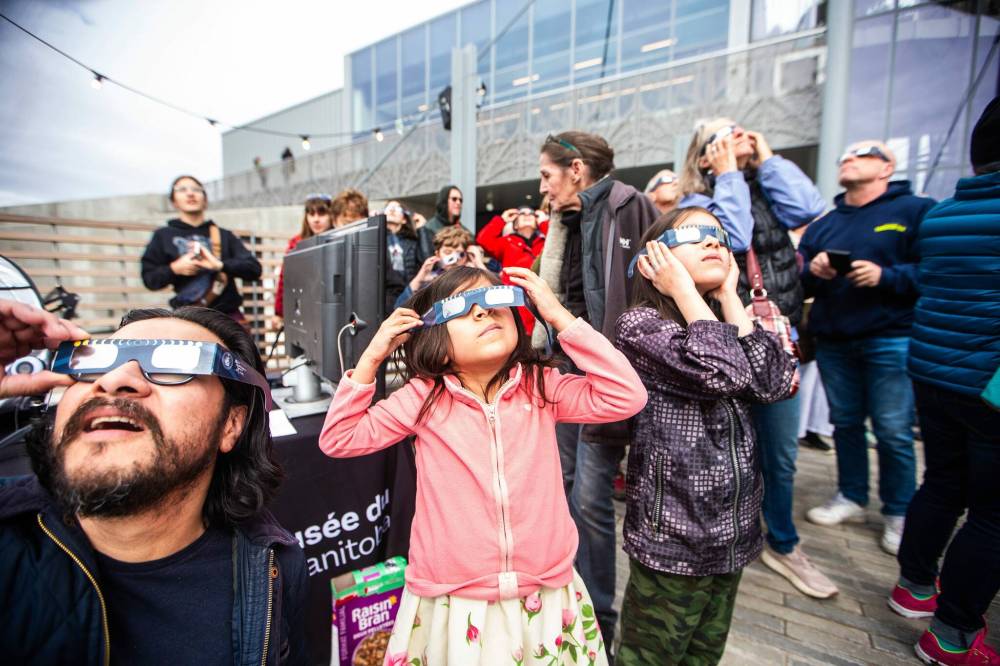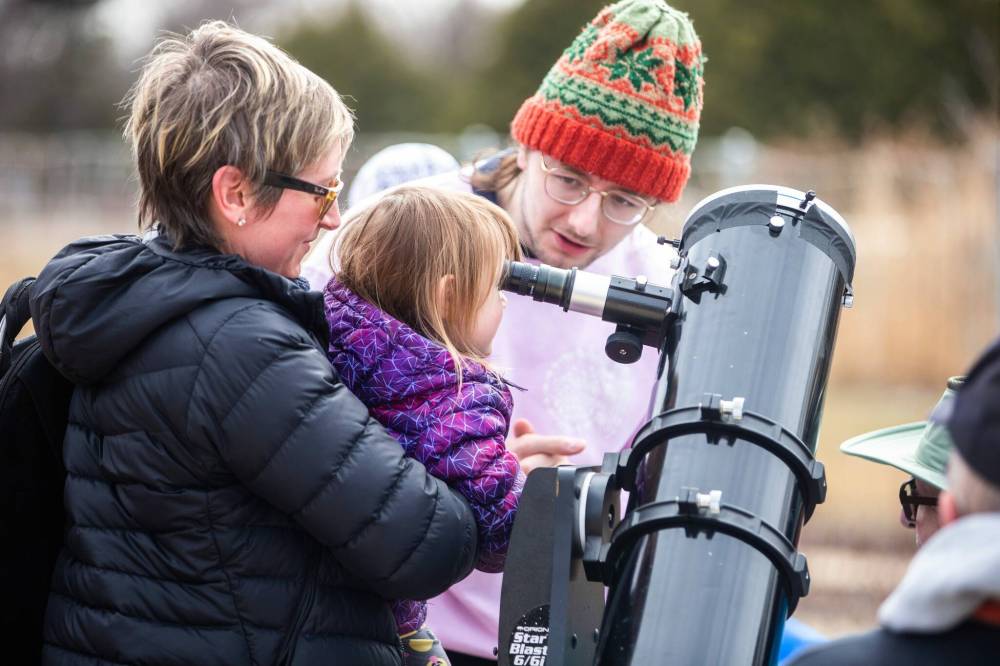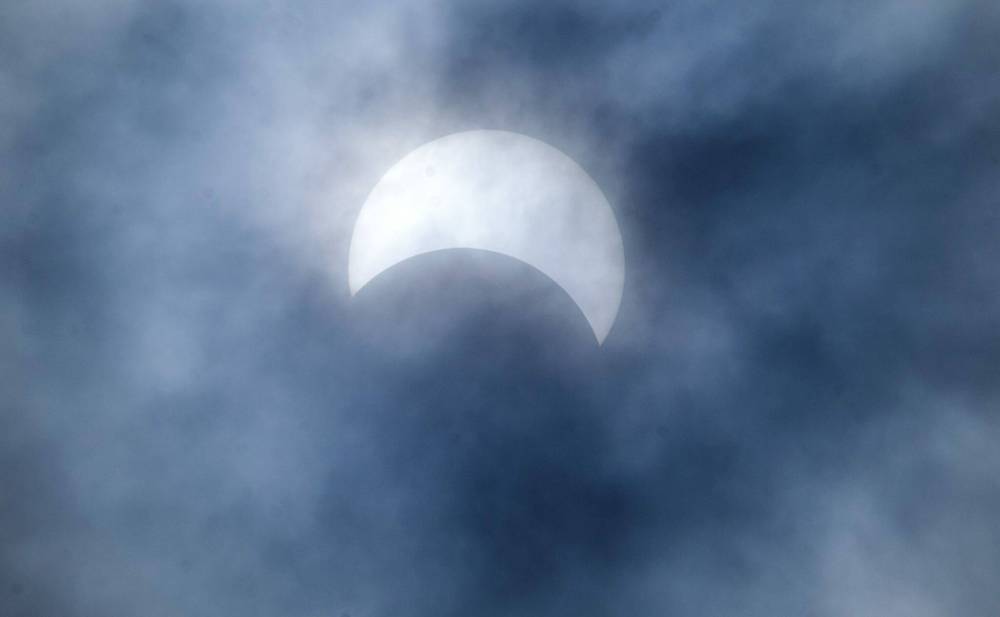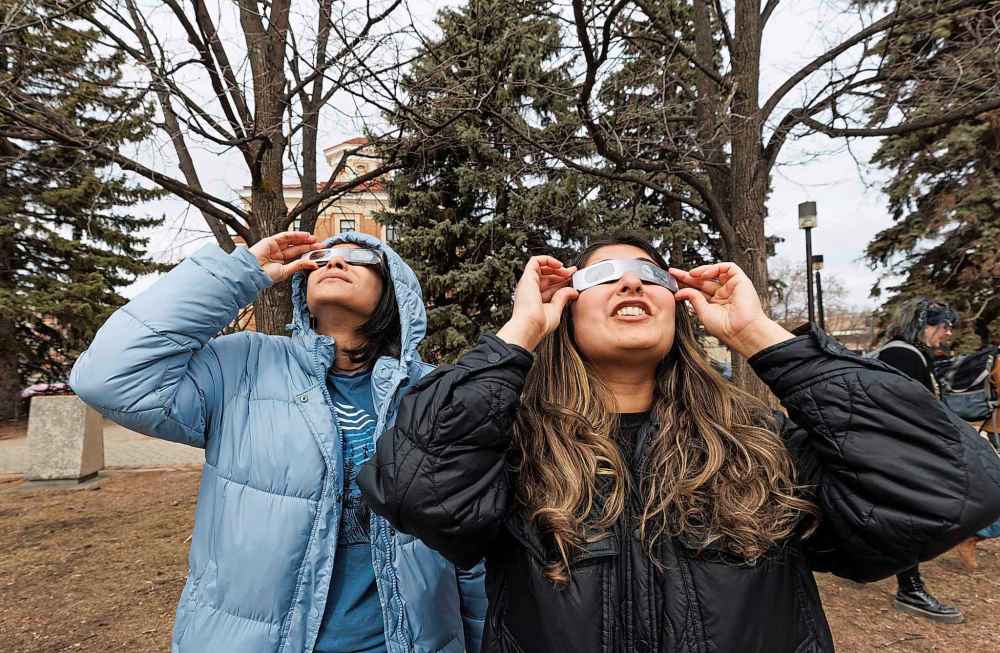It was a science class to remember for Thomas and Loa Strang.
The siblings took to the Leaf at Assiniboine Park Monday with their mother — and home school teacher — holding homemade pinhole projectors to catch a glimpse of the partial solar eclipse, which attracted nearly 1,000 people to the outdoor patio and surrounding lawns.
In the days leading up to the astronomical event, the six- and four-year-olds learned about eclipses, their frequency and other celestial fun facts.
“We used this as an excuse to learn and have some fun,” said mother Stephanie, while the trio waited in line to use one of several telescopes set up for the public.
Overcast conditions didn’t bode well for the use of their DIY projectors, which uses sunlight to project an image of the eclipsed sun through a small hole in an object and onto a surface, allowing viewers to safely observe it.
“The eclipse is reminder that there’s something bigger than us out there,” Strang said.
Nearby, long-time Royal Astronomical Society of Canada member Laura Egler parked herself on the lawn with a telescope and eclipse-specific binoculars before the sun’s veiling reached its “peak of totality” around 2 p.m. central time.
“Not a lot of people look at nature anymore because they’re so absorbed by their cellphones, that’s what draws people to things like this,” she said.

MIKAELA MACKENZIE / FREE PRESS
Rafael, Isabel, and Gabriel Reyes watch the solar eclipse at a viewing party at The Leaf in Assiniboine Park on Monday
Despite overcast conditions, the mild spring weather drew amateur astronomers, families and students playing hooky for a look at the spectacle, which Canadians haven’t seen since the last one in 2017.
Monday’s solar eclipse travelled through parts of North America, from Mazatlan, Mexico, through southeastern Ontario, across Montreal and on through the Maritimes.
Those who were lucky to see the eclipse in the “path of totality” saw the moon block out the entire sun for as long as four minutes. Winnipeggers looking up to the sky saw a 60 per cent eclipse, which resembled a crescent rather than a ring of fire.
In 1979, Winnipeg was in the path of totality as a school-aged Scott Young was mesmerized. That’s the moment the Manitoba Museum Planetarium astronomer was hooked.
“The entire horizon was covered in the colours of twilight and my head just exploded,” he said, as the partial eclipse Monday was shrouded in clouds behind him.

MIKAELA MACKENZIE / FREE PRESS
Willa Gerullis, age two, and her mom, Sara Gerullis, look through a telescope at the solar eclipse viewing party at The Leaf, Monday.
Young set up shop outside the Leaf with a telescope and television, sharing the experience with others donning ISO-certified eclipse glasses, made from polyester film coated in aluminum and 100,000 times darker than regular sunglasses.
Around the peak of the sun’s eclipse in Winnipeg, drivers parked their cars on the roads snaking through Assiniboine Park to watch the spectacle unfold through eclipse glasses, welder’s goggles and masks — although the use of the latter options were widely discouraged by the Manitoba Association of Optometrists, who recommended eclipse watchers adhere to the ISO 12312-2 international standard.
Across the city at the University of Manitoba, students milled about at the school’s central park the Quad to be one of 500 to get a pair of eclipse glasses, which have been sold out at stores across the city.
Vianm Isla, Karylle Cabbelo, Shann Galanto and Sofia Alcasabas were a few of dozens of students waiting at the green space to see if they could snag a pair of glasses for the event. The university hosted an eclipse viewing party with 3D-printed telescopes designed by adjunct professor and medical physicist Dr. Daniel Rickey.
“I’m very fascinated with the universe and its theories, I missed the eclipse in 2017 and I didn’t want to miss this one,” Alcasabas said.

MIKAELA MACKENZIE / FREE PRESS
Monday’s solar eclipse travelled through parts of North America, from Mazatlan, Mexico, through southeastern Ontario, across Montreal and on through the Maritimes.
At the guidance of Manitoba Education and Early Childhood Learning, some divisions kept students indoors during the event while other schools used the it as an educational opportunity.
The absence tracker at Louis Riel School Division recorded 22 per cent of students missing from classes Monday, up from 14 per cent on Friday.
Back at the Leaf, Young counted down the moments until the peak of the eclipse, before snapping a selfie with other sun gazers.
“People realize the alignment that’s happening includes the sun and the moon, the Earth, and them. We’re all in a perfect line and it reminds us that we’re part of the cosmos, it’s not just starry wallpaper that’s out there,” he said.
Monday’s event was the last total eclipse to affect North America until 2044.

MIKE DEAL / FREE PRESS
University of Manitoba students, Pari Joneidi (left) and Zahra Nanji, watch the solar eclipse with other students gathered on the Quad at the U of M, Monday.
nicole.buffie@freepress.mb.ca

Nicole Buffie
Multimedia producer
Nicole Buffie is a multimedia producer who reports for the Free Press city desk.